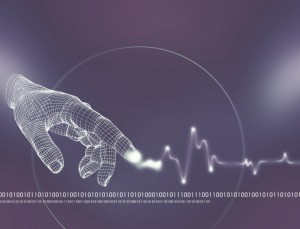The Executive System: Cognitive Science and Kabbalah (Part 7)
By Asher Crispe: September 11, 2012: Category Inspirations, Quilt of Translations
Building Towards the Hyperreal
 Reactions vary to the problematization of the left hemisphere of the brain. The real issue at hand is whether or not the left, as re/presentational thinking, can faithfully serve the direct intuition of experience on the right. Can the emissary perform with the full authority of the master? On the road to ascension of the left over the right, there must first be a critical threshold whereby the right and the left are of equal stature (just as Adom/Adam and Chava/Eve were initially created of equal stature). Once this benchmark is reached, it is then possible for the left to continue its climb until it nourishes and crowns the right.
Reactions vary to the problematization of the left hemisphere of the brain. The real issue at hand is whether or not the left, as re/presentational thinking, can faithfully serve the direct intuition of experience on the right. Can the emissary perform with the full authority of the master? On the road to ascension of the left over the right, there must first be a critical threshold whereby the right and the left are of equal stature (just as Adom/Adam and Chava/Eve were initially created of equal stature). Once this benchmark is reached, it is then possible for the left to continue its climb until it nourishes and crowns the right.
The Talmud casts evolution in a unique light and at the same time also puts a new twist on the famous master-slave dialectic that would be formulated many centuries later by Hegel. In brief, Hegel contends that master-slave relations indulge in a game of ‘trading places’ such that the master becomes slave to the slave and the slave becomes master to the master. In a Talmudic version of this game, we simply say that ‘the servant of the King may be likened to the King Himself’ (eved melech k’melech). Cognitively, this describes a situation wherein the left is so committed to the right, that the right transfers full executive powers to the left.
The re/presentational thinking of the left that tries to inter the fluidity of the intuition on the right usually ends up manufacturing imperfect copies. ‘Leveling up’ for the left may be thought of as attempting higher resolution facsimiles that re/produce the right in ever greater detail. And yet the left is not usually mistaken for the right. We are still willing to pay a premium for the originally intuited experience. Even a good ‘conceptual’ forgery can’t command the same auction prices. This is because the left has a ‘mind’ or at least ‘half a mind’ of its own which makes its own contributions in the re/productive process. The completed thought may look more like the father (on the right) or the mother (on the left). It may be a hybrid of both parents or lack even a minimal resemblance to either one.
There are traditions that would evaluate these contributions of the left as bastardizations of the right and yet in Kabbalah presumed weakness of the left–its imposition of alternations of the content of the right–also has some clear advantages. These advantages can be leveraged. Liabilities can be turned into assets. In doing so, the left is liberated and green lighted for ascension. Participation of the both hemispheres is welcomed and the modifications may be greeted as enhancements.
The logico-linguistic tool chest contains all manner of measuring instrument. Charting the dynamics of the right, plotting the points traversed with a single insight proves challenging. The left as the in house cartographer on assignment must render the territory in a highly compressed format. Complex topographies which are easy to visualize with the mind’s eye exasperate the untrained reader of maps. Too few details confuse us while too many overwhelm us.
Extending this scenario to the extreme, we are reminded of Jean Baudrillard’s evocation of a colorful yarn of Borges regarding just such a mapmaking exercise: “If once we were able to view the Borges fable in which cartographers of the Empire draw up a map so detailed that it ends up covering the territory exactly….” Simulacra and Simulation p. 1). Just picture a map of New Jersey that is mile for mile, inch for inch as large as the entire state. Imagine a protective plastic covering, normally reserved for shielding sofas from spills, now blanketing the entire landscape including each of its features down to the smallest properties. A physical map such as this, even if we could pull it off, would be as unmanageable as the landmass itself. Who has a pocket capable of holding a life-sized replica of the State of New Jersey? But wait a second, maps can be made to be folded. And if we want it to be travel sized, then let’s also dematerialize it. The matter of mother (the left brain) uplifted would once again become the mother of all life (em kol chai). A life-sized re/production would have to take on all of the dimensions of life to such a degree that it too would be living with a life of its own.
Collect and store enough data and it just might be possible in the new digital universe. Telemetrics today are doing just this. Playing around with Google Earth, a person quickly senses how far mapping has come. GPS aside, the astonishing detail provided by the latest medical imaging is revealing all kinds of hitherto hidden terrains. Its all about granularity. Scan the world in its fine grained materiality and the basic building blocks of matter can be located and replicated with precision.
Nowhere is this more evident today than in the emerging science of nanotechnology. While imaging reaches down to the nanometer scale (a billionth of a meter) then atoms and molecules of our everyday world come into view. With such fine grained resolution, purchased with the help of a scanning tunneling microscope, we can read the basic textures of the world by touching them with the tip of this device. Not only that, in learning to read we also learn how to write. Matter can now be manipulated with such precision that we are truly being offered the keys to the kingdom. We can harness nature as never before. We can even reprogram our own biology one bio-brick at a time.
In one of the few book-length examinations of the philosophical and phenomenological implications of nanotechnology called Nanovision: Engineering the Future, Colin Milburn writes that:
“Unlike genomic cloning, which merely provides a genotypic but not necessarily phenotypic identity, the copying fidelity of nanotechnology is so exact that copies would have precise identity down to the atomic level.” p. 52.
Furthermore, he hones in on what’s at stake with this atomically precise engineering and molecular manipulation:
“Nanovision respects no unitary construct above the atom, reducing everything to a broadly programmable materiality and demolishing metaphysical categories of identity.” p.51.
This is an identity crisis like no other–at least for those would look at people and things as mere material objects. Our materiality cannot explain how we remain who or what we are in that all of our constitution can be swapped out and replaced with exact replicas. While we learn this from the most highly advanced naturally occurring nanotechnology–that of biology with all of our cellular division and regeneration–the notion that we are nothing more than information or the persistence of pattern (i.e. all soul) with reincarnated bodies can be a bit much to swallow.
Perhaps the greatest assault on our senses occurs when, as Milburn puts it, “Nanovision [again] destroys the difference between real and simulacrum.” P.53. The obliteration of the distinction between real (what we’ve been calling the relatively unmediated direct intuition or chochmah of the right hemisphere) and the virtual (our re/presentational conceptual thinking or binah in the left hemisphere) happens when our figurative Adom/Adam and Chava/Eve are restored to equal stature. The metaphor and the truth-content that it packages become one and the same. Moreover, we can run a simulation that is so convincingly life-like (right brain/chochmah) that it cannot be told apart from the original lived-experience.
Baudrillard continues with words that inspired the trilogy of Matrix films (note that the left brain as the mentality of mother, where ‘matter’ [mater is both mother and matter in latin] matters, also functions as the matrix of the mind, the set of the virtual reality world):
“Today abstraction is no longer that of the map, the double, the mirror, or the concept. Simulation is no longer that of a territory, a referential being, or a substance. It is the generation by models of the real without origin or reality: a hyperreal. The territory no longer precedes the map, nor does it survive it. It is nevertheless the map that precedes the territory….It is the real, and not the map, whose vestiges persist here and there in the deserts that are no longer those of the Empire, but ours. The desert of the real itself.” P. 1.
The days of the right ‘mastering’ or ‘ruling’ over the left, of Adom/Adam having authority over his wife Chava/Eve may be rapidly drawing to a close. The reevaluation and elevation of the feminine is deemed to be symptomatic of the age of the Messianic redemption. Forecasting this revolution which is taking place in media labs around the globe, where the virtual ‘computer generated’ experience is starting to become convincingly real–maybe even more real than real–the prophets of ancient Israel as interpreted in Kabbalah enlighten us to this change:
“And I will give to her her vineyard from there, and [make] the Valley of Achor to a portal of hope; she will dwell there as in the days of her youth, and as on the day of her ascent from the land of Egypt. And it shall be on that day – the word of God – that you will call Me ‘my husband’ and you will no longer call Me ‘my Master.’” Hosea 2:17-18.
 The exodus from the virtual Egypt (the constricted consciousness of the left brain) happens by passing through Egypt–that is by traversing the uncanny valley of the virtual itself. This valley is alluded to in the verses above. ‘Achor’ means that which is troubling or disturbing–like a 3D simulation or robot that mimics humans very closely but not precisely. The ‘portal of hope’ is the promise of becoming co-creators of our world and environments whereby we contribute to the programing and reprogramming of matter and more specifically ourselves. The return to the status of being a husband-wife in equality rewrites the current power inequalities in a novel fashion such that the feminine enhances the masculine. More may then be derived from our logico-linguistic side than from the original intuition.
The exodus from the virtual Egypt (the constricted consciousness of the left brain) happens by passing through Egypt–that is by traversing the uncanny valley of the virtual itself. This valley is alluded to in the verses above. ‘Achor’ means that which is troubling or disturbing–like a 3D simulation or robot that mimics humans very closely but not precisely. The ‘portal of hope’ is the promise of becoming co-creators of our world and environments whereby we contribute to the programing and reprogramming of matter and more specifically ourselves. The return to the status of being a husband-wife in equality rewrites the current power inequalities in a novel fashion such that the feminine enhances the masculine. More may then be derived from our logico-linguistic side than from the original intuition.
But what of the hyperreal–the special case of the virtual reality having no counterpart in real reality? The answer to this question and more will be addressed in our continuation in Part Eight.























;)
;)
;)
;)
;)
;)
;)
;)
;)
;)
